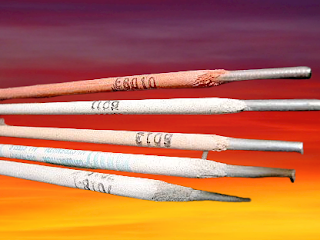Welding Electrode Selection Chart
 |
| welding_electrode |
Electrode identification. Since there are many types of electrodes, the American Welding Society (AWS) has established a numbering system that is used by the welding rod.
The Canadian Standards Association standard for mild and low
alloy steel electrodes is W48-1M, which is roughly the same as the American
Welding Association A5.1 standard. The difference lies in the fact that CSA
uses the SI metric, and AWS still uses the inch-pound system to indicate the
tensile strength of an electrode. CSA uses Megapascals (MPa). In the case of
the E7024 electrode, 70,000 pounds per square inch translates to 480,000 MPa.
Under the CSA specification, E7024 becomes E48024, but the requirements that
the electrode must meet are the same in both cases.
This is how the numbers read: welding electrode.
1) The letter "E" indicates that the rod is
intended for arc welding.
2) Next two numbers (if four numbers are used) or three
numbers (if five)
numerals are used) multiplied by 1000 to indicate the
tensile strength of the weld
metal in psi. The next-to-last number indicates the position
in which
electrodes can be used. Position flat, horizontal, vertical, or.It might be possible
overhead.
3) Here, a number 1 will indicate that the electrode can be
used in all
positions. A number 2 would indicate that the electrode
could only be
used in a flat position
4) The last number indicates the electrical characteristics
of the electrodes,
i.e,. AC, DC, and DC directly or reverse. This is the last
number
This is somewhat unreliable due to the type of electrodes used today.
For example, an E7024 electrode would have the following
characteristics:
E - electrode (arc welding)
Multiplying by 70 - 1000 means 70,000 psi (pounds per square
inch) tensile strength.
2 - flat position
4 - AC and DC (straight and reverse)
E7024
 | ||
Electrode identification
|
 |
| welding joints |
 |
| welding position |
Welding Electrode Selection Chart | वेल्डिंग इलेक्ट्रोड चयन चार्ट
| Base Metal (धातु) | Common Electrode | Welding Position | Current Type | Polarity | Notes |
|---|---|---|---|---|---|
| Mild Steel (MS) | 🧪 E6013 / E6011 / E7018 | All Positions | AC / DC | AC or DC+ | General fabrication, clean weld |
| Carbon Steel | E7018 | Flat / Horizontal / Vertical | DC | DC+ | Low-hydrogen rod for structural work |
| Cast Iron | ENi-CI / ESt | Flat / Horizontal | DC | DC+ | Preheating recommended |
| Stainless Steel | E308L / E309 / E316 | All Positions | AC / DC | AC or DC+ | Corrosion resistance, food grade |
| Aluminum | ER4043 / ER5356 (TIG/MIG) | Flat / Horizontal | AC (TIG) | AC | Use a pure tungsten electrode |
| Galvanized Steel | E6011 / E6013 | Flat / Vertical | AC / DC | AC or DC+ | Ventilation is important (zinc fumes) |
| Low Alloy Steel | E7018-A1 / E8018 | All Positions | DC | DC+ | High-strength structures |
| High Carbon Steel | E8018 / ENiFe-CI | Flat | DC | DC+ | Preheat and slow cooling are recommended |
🔍 Quick Guide by Application
| Application | Recommended Electrode | Why? |
|---|---|---|
| 🏗️ Structural Welding | E7018 | Strong, low hydrogen |
| 🚗 Automotive | E6011 / MIG Wire | Deep penetration, versatility |
| 🛠️ General Repair | E6013 | Easy to use, smooth arc |
| 💧 Pipelines | E6010 / E7010 | Deep penetration |
| 🧼 Food Industry | E308L | For stainless steel sanitation |
⚠️ Key Symbols Explained:
-
E6013 = Easy arc, medium penetration
-
E7018 = Low hydrogen, high-strength weld
-
E6011 = Deep penetration, works on dirty/rusty metals
-
E308L = Stainless steel welding (304 grade)
-
E7010 = For pipe welding (cellulosic rod)
✅ Electrode Selection Tips:
-
🔎 Know your base metal – Match the electrode to the metal.
-
🧪 Choose correct polarity – DC+ for deeper penetration.
-
🔥 Check position – Use position-appropriate electrodes.
-
🧯 Use safety gear – Always weld with proper PPE.
-
🛠️ Try on scrap first – Practice before production welding.








0 Comments
Leave a Reply...